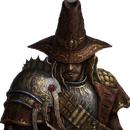"Our forest is dying. We are in a time of crisis. The Eonir must not be complicit in our forest’s decay. Appealing to the Human nobles will not change the situation, but if we can raise awareness amongst their hunters and woodsmen, then I think it is worthwhile."
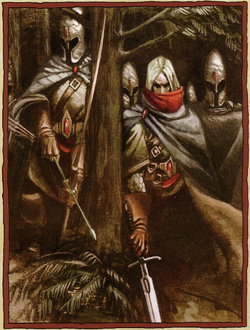
An Eonir warband[3e]
The Eonir are an enclave of Wood Elves dwelling in Laurelorn Forest. Although they share a similar origin to the Asrai, their cousins in Athel Loren, they are considerably less isolationist, engaging in peaceful, though occasionally strained, diplomatic relations with the Men of the Empire.[1h][2a][2b]
History[]
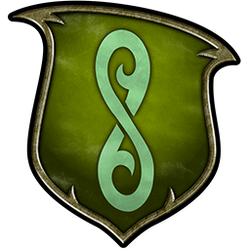
The icon of the Wood Elves of Laurelorn in Total War: Warhammer II.
The Wood Elven realm of Laurelorn began life as a thriving colony of Ulthuan, founded thousands of years before the War of the Beard. During that period, the High Elves controlled most of the non-mountainous areas that are today the realms of the Empire, Bretonnia, Estalia, Tilea, and Kislev.[1b] The cataclysm known as The Sundering resulted in 600 years of isolation, during which the colonies united and declared themselves the 11th Kingdom of Ulthuan, ruled by a High Council of lords from the largest princedoms. During this period, only a few Elf outposts existed in the Laurelorn.[7a] The Laurelorn's forest spirits appeared less hostile than those of Athel Loren, which had refused to share the woods with Elf settlers. A Handmaiden of the Everqueen launched an expedition to study the forest spirits, leyline network, and lost Old One ruins in the area. Before long, two large settlements grew at Tor Lithanel and Kor Immarmor, and a road network connected the Laurelorn with the other colonies. The Elves of Elthin Arvan viewed the beautiful forest as a retreat comparable to Avelorn, the spiritual home of Elves in Ulthuan.[7a]
The War of the Beard between Elves and Dwarfs strained the relationship between the court of the Phoenix King and the High Council of Elthin Arvan. The colonists' strategic priorities were different from those of Ulthuan, meanwhile generals from Ulthuan were given command of the colonial armies. The Phoenix King's final decree to abandon the colonies was taken as a betrayal, for without assistance from the Dragons and legions of Ulthuan, there was little hope to defeat the Dwarfs. The Laurelorn was amongst the last colonies to hold out when Kor Immarmor was destroyed and Tor Lithanel placed under siege. The Eonir feared that without reinforcements, another Dwarf assault would end with the woodland realm being destroyed. In desperation, they turned to the disgraced Grey Lords, mages that had retreated into the forest to study the artifacts of the Old Ones. The Grey Lords summoned a spirit army from the forest's depths. The advancing Dwarf throng marched into the forest to meet this new foe and was never seen again.[7a]
The Dwarf kingdoms had been devastated by the war, and they had much larger issues than a few Elven hold-outs. During the period directly after the Elven withdrawal, the settlements in Laurelorn and Athel Loren became focal points of Elven survival in the Old World.[1b][2a] Refugees were given assistance and allowed to settle in the woods, but were always regarded as guests in the Golden Wood. The original colonists grew arrogant and considered themselves to walk the true path of elven tradition. It was during this time that a distinct Eonir culture emerged.[7a]
Since their independence from Ulthuan, the Elves of Laurelorn have defended their forest against Dwarfs, Orcs, Humans and even marauding bands of Dark Elves.[1c]
After the disappearance of Emperor Sigmar, the forest of Laurelorn was claimed by the Elector Counts of Drakwald, Middenland, and Westerland. However, the Wood Elves acknowledged no overlord and defeated all attempts at conquest. Their most important victory occurred in 897 IC, when they overwhelmed the army of the Drakwalder Count, whom history remembers only as "the Unlucky."[1d] When Drakwald was absorbed by Middenland, their claims to Laurelorn also passed to that province.[1e]
During the Skaven Wars, the Eonir aided Mandred Skavenslayer in his war against the vile ratmen.[2d] They allowed his army to march north out of Carroburg through Laurelorn Forest. This allowed them to avoid the much more dangerous routes through Skaven-infested country, and to surprise the ratmen at Dietershafen. In addition, the army travelled through the forest for only a few hours, but covered a distance that should've taken days. However, numerous soldiers were lost in the forest, lured by phantom voices or beckoning hands. Those soldiers who strayed from the path opened to the army were never seen again.[4a]
Relations with other Elf realms have improved as well. When the beastlord Morghur appeared in the Forest of Shadows in 1337 IC, the Eonir aided their Asrai cousins in tracking the creature. Dialogue with the Phoenix Crown resumed in the 21st century when King Finubar of Ulthuan finally acknowledged Tor Lithanel's independence, millennia after its secession. In recent years, Eonir envoys have sailed to Naggaroth with trade offers in exchange for a cessation of raids on the Laurelorn's coastline.[7b]
Circa 1700 IC, the Eonir made an agreement with the Count of Nordland, allowing Humans to settle in the land between the rivers Salz and Demst, but strictly limiting how many can settle, and requiring that the Elves approve any new settlement before it is constructed. The Elves typically do not approve many settlements, and when they do, severely restrict what can be harvested from the woods.[7c][1h]
In recent years, the Queen of Laurelorn established a camp of Eonir in the Amber Hills outside of Altdorf, with the purpose of observing Imperial politics, and occasionally intervening in matters relating to Laurelorn. Although the camp is considered "temporary" by the Wood Elves, this has a very different meaning for such a long-lived race. Mainly because of the camp, Eonir are an increasingly common sight in Reikland.[2b]
Storm of Chaos[]
|
Attention, Empire Citizens!
This article or this section of the article contains information regarding the Storm of Chaos campaign and its aftermath, which is now considered a non-canon, alternate timeline.
|
"Gausser is nothing but a pawn of the Laurelorn Elves."
His nobles have pressured Grand Baron Theoderic Gausser of Nordland to renegotiate the treaty with the Eonir. Impatient as ever, some Humans have made illegal settlements in the area, which the Elves have threatened to remove by force, if need be. Some observers fear a coming clash between the Elector Count's knights and the warriors of Laurelorn, but the war has held Salzenmund's hand, so far. There are worries, however, that the Elves may see this as a time to assert their rights.[1g]
Twenty-five miles south of Hargendorf on the west bank of the River Demst sits the abandoned village of Schlaghügel. Founded in the time of the current Baron von Hargenfels' grandfather, the village was an attempt to slowly begin colonisation of the lands west of the Demst. One attraction at the time was the presence of an old stone circle, of the kind build by followers of the Old Faith long ago. The Baron, himself a member of the Cult of Mother Rhya, felt this was a holy site and wanted to preserve it and make it active again. Forty families were sent there to start new lives. At first garrisoned, after a few years of quiet it seemed like the Elves of Laurelorn would tolerate this settlement; some even came to trade. Then, one summer night five years ago, the people of Schlaghügel vanished: Traders reported the village empty. Klement, the current Baron von Hargenfels, sent his bailiff to investigate. He confirmed the reports: All the people were gone. There were no signs of violence or struggle, no corpses, no indication of where they had gone. Even the animals were missing. The only clues were two words carved on the tree in the village commons: "fog" and "mercy."[1i]
Investigations turned up nothing, and the village was written off as a mystery. The "official" explanation claimed the people fled into the woods to escape taxes, but no one really believed this. When the subject came up, the word "cursed" was most often heard, and a connection to the ancient circle "that should have been left alone." Then, traders along the Demst started reporting that the people of Schlaghügel had come back - odder still, they acted as if they had never been gone. Baron von Hargenfels was concerned. If true, then this story told of bizarre and possibly threatening goings on. The Baron, therefore, wanted an explanation, and hired a group of adventurers to act as his agents and investigate the mystery of Schlaghügel. When they arrived, they found all as described: prosperous, happy villagers with no memories of ever being gone. Two things stood out, however: the village priest had not returned, and there was a door into the hill on which the stone circle sits that was not there before. Besides, there were Elves watching from the woods...[1j]
Government[]
"I recall Elf dignitaries — they insisted we call them ‘Eonir’ — visited us in Altdorf, after ages of exchanging carefully worded letters. Father would have preferred to send some envoys of his own, flanked by his knights in polished armour, but they refused to allow us into their forest. When they finally came, I took my seat next to father but quickly became enraptured with their ways; their poems and songs had a distant melancholy about them that Imperial Elf minstrels seem to hold back."
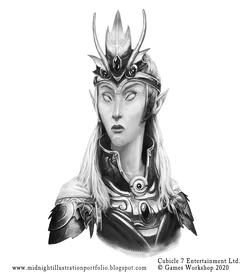
Queen Marrisith, the Queen of Laurelorn Forest
The Laurelorn has been an independent monarchy since the War of the Beard, when the Phoenix King of Ulthuan ordered the colonies of Elthin Arvan to be abandoned. Prior to the crowning of the first Queen, the colony had been governed by a High Council and ruled by the Phoenix King. After Tor Lithanel seceded from Ulthuan, a Triumvirate was given authority over the High Council and an advisory Senate was created. The Eonir consider their government to be the most democratic of the Elf realms, because decisions are usually made by council votes instead of royal decrees.[7e] The royal family can trace her lineage back to a Handmaiden of the Everqueen who was the daughter of Morelion, making her part of Line of Aenarion.[7e] The monarchy of the Laurelorn is determined by matrilineal succession, a tradition that harkens back to the Everqueens of Ulthuan before the coming of Chaos. By this ancient tradition, a king can only be crowned if there is no female heir.[7e] The current queen is called Marrisith, who is the fourth queen to rule the Laurelorn.[7e] [2a]
High Council[]
Tor Lithanel is governed by a council representing each of the major Houses from the Ward of the Sun (the Laurelorn’s capital region) plus three of the four vicarii from the border wards (one vicarius always serves as a prefect instead). All High Councillors are Toriour (Cityborn) kindred. In addition to governing Tor Lithanel, the High Council receives embassies from the Empire and decides upon treaty conditions.[7e]
Triumvirate[]
The Triumvirate is the high court of Laurelorn. When the High Council reaches an impasse, the Triumvirate’s decision is final. The Triumvirate consists of Queen Marrisith and two prefects. One of the prefects is elected yearly from amongst the four ruling vicarii. The other prefect is the Queen’s champion ('The Festival Lord') who is chosen by a festival of games that concludes with trials by combat. The winner of these games is deemed to have been granted Asuryan’s approval to ascend to the Triumvirate. The Triumvirate quietly observes High Council proceedings until called upon to vote. The council may assemble without the Triumvirate being present. When the Triumvirate is absent from proceedings, a wizened old arbiter named Yadoh maintains order by slamming a halberd haft on the marble flagstones. Yadoh is at least 4,000 years old, served as the first Queen’s champion, and still remembers the War of the Beard.[7e]
Senate[]
Once every season, the Senate assembles in Tor Lithanel to discuss matters of diplomacy involving the Eonir’s neighbours, or the Laurelorn’s overall defence. Emergency Senate sessions can be called in times of crisis. Senators are respected elders, warriors, and scouts from each of the four wards that make up the greater Laurelorn. Senators propose specific courses of action to the High Council based on their frontline experiences, but they hold no political authority. Elves of the Faniour (Forestborn) kindred rarely attain office higher than senator.[7e]
Foreign Relations[]
Although both Middenheim and Nordland claim Laurelorn forest, the Eonir remain fiercely independent. Neither province has been able to exert control over the realm.[1b][1c][1e] The Wood Elves value their privacy: If the Empire wished to send an army to subjugate Laurelorn, they would have a difficult task, for the villages of the Eonir are protected from sight by fey enchantments.[3a] However, this would be unlikely to happen, for the Eonir try to maintain good relations with the surrounding realms of Mankind. The Elves realize that they provide a defensive bulwark against the Greenskins and forces of Chaos.[1b]
Although the Eonir would prefer to be left alone in their woodland,[1b] they recognize that is necessary to have diplomatic relations with nations such as the Empire, and thus are far less isolationist than their Asrai cousins.[2b][1c]
Physiology[]
In the Empire, residents commonly call the Elves of the Laurelorn "Wood Elves," to distinguish them from the "Sea Elves" that sail the great trading ships and inhabit Marienburg's Elf Quarter, and the "High Elves," those who inhabit Ulthuan. This is a false distinction. There are no physical differences between the three groups, although there are cultural differences.[1b]
Society[]
"All creatures have their obligations to the land. It is how we choose to interpret those obligations that define us. We have forsaken the path of smoke and the wheel. To embrace those who walk that path is not permitted to us."
- —Laurelorn Elf.[4a]
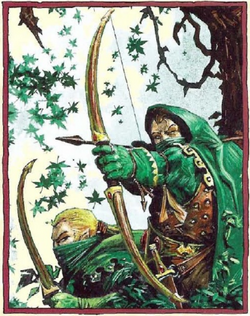
The guardians of Laurelorn.
Eonir Elves are divided into three 'social classes' according to their family's heritage, known as 'birth kindreds'. During the War of the Beard, the original settlers found themselves outnumbered by refugees, so they formed a support network to protect their interests. The refugees in turn became kindred for mutual protection in the hostile new environment. When the war ended, the Eonir had become accustomed to this new paradigm of looking down their noses at each other, so birth kindred divisions remained. Birth kindreds do not denote noble or common blood, in fact several banished nobles are members of the lower class.[7d]
In Eonir society, all Elves are born into social classes called 'kindreds'. The two primary kindreds of Eonir society (Toriour and Faniour) are named after the Eltharin words for 'city' (Tor) and 'forest' (Fan) combined with 'Oriour', meaning 'birth' or 'blood'. The Younger Kindred was a later addition to Laurelorn, named after the Athel Loren kindred of Harioth, meaning 'youth, boundless energy, and jealousy'. Vocational kindreds (for scouts, spellsingers, and so forth) are named after their Asrai counterparts, although Eonir rarely identify with peer groups beyond the local (Kithband) level.[7a]
- Cityborn Kindred (Toriour): Descendants of the original Tor Lithanel colonists are the upper class in the Laurelorn. Toriour kin have lived for generations in the buildings (or restored ruins) that remain from the original colony. They occupy the highest positions in government due to an ancient decree protecting settlers’ rights.
- Forestborn Kindred (Faniour): The middle class comprises descendants of refugees who took shelter in the Laurelorn during the War of the Beard. Faniour kin live in the woods surrounding the original settlements, where they enjoy the privacy of their treetop dwellings. The majority of the Eonir are Forestborn.
- Younger Kindred (Harioth): Elven families who arrived in the Laurelorn after the War of the Beard are not considered to have a birth kindred. Harioth kin are treated as the lower class in Eonir society. New arrivals live in caves and ruins at the edge of the Laurelorn or wander the forest as vagabonds. Second generation Harioth kin can attain membership in the Faniour Kindred by passing a series of trials. Those who fail often migrate to the Empire.
These birth kindreds are the only universal kindreds in Eonir society. Unlike the Asrai, who form bonds of common interest with Elves from all over Athel Loren, Elves of the Golden Wood limit vocational kinship to the local (Kithband) level. Kithbands are smaller social groupings who come together to pursue a common interest or agenda, engaging in activities as diverse as singing and warfare. For example, an Elf of the Cityborn Kindred might also belong to a local Minstrel Kithband which includes neighbouring Forestborn kin. Despite this shared interest, she would feel little kinship with Forestborn from outside her Kithband, even other minstrels.[7d] Often kithbands form up into military groups. In this case, their members are known as Kithband Warriors.[3b]
Culture[]
"I invited one of their singers into my parlour. She seemed like a young woman, but laughed at the notion and said she had several adult children — they all seem to steal the youth and beauty from around them. She shared their version of ‘dreamwine’ with me, which she said came from the River Demst and the honeysuckle and jasmine that grows there. I presume it has nothing to do with that substance that is said to come from a single vinyard in the Grey Mountains. It was sweet like cream but light and airy. After she left and I retired, my dreams carried me over a great forest — the Laurelorn. I saw many things in those dreams. A pair of Elf men were in a slender boat, fetching a net full of salmon from a river. Somewhere else a woman crushed dark berries into a wooden bowl, skimming the juice from pulp, while a pair of children sat at her feet."
- —Isabella, Imperial Noble, on her first impressions of the Eonir[7b]
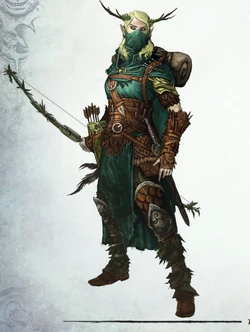
A typical Eonir in their forest attire
Details on life in Laurelorn are difficult to come by, as any elf who divulges such information is subject to exile.[6a] The Eonir inhabiting the Laurelorn are a distinct elven culture that bears similarities to both the Asrai (Athel Loren) and Asur (Ulthuan). Although Humans consider Eonir to be 'Wood Elves', there are several key differences between the Eonir and Asrai. Eonir are not spiritually bound to the forest by ancient spirit-pacts in the same way Asrai are bound to Athel Loren. The Eonir's relationship with forest spirits is weaker, and they're more inclined to venture from their glades to interact with outsiders.[7d] In fact, the kingdom of Laurelorn is older than Athel Loren and retains elements of Asur culture from the original Ulthuan colony. Eonir regard the Asur as hypocrites who abandoned the Old World, and then had the audacity to dispute Laurelorn's independence. On some level, Eonir sympathise with the Druchii of Naggaroth because they were also ostracised by the Asur.[7a]
Eonir religion recognises the entire pantheonic mandala, making them spiritually closer to Asur than Asrai. Meditation, divination, and burial practices vary according to birth kindred. Cityborn (Toriour) kin bind deceased souls into gemstones, whereas departed Forestborn (Faniour) souls are surrendered to the Weave and often reincarnate as Tree Kin. Eonir settlements are organised by a longstanding genealogical tradition that distinguishes between settler and refugee families.[7d]
Unlike Men, who seek to tame the lands in which they live, the Elves of Laurelorn regard the forest and its land as a living thing, something they should live in harmony with, something over which they feel protective.[1b] For this reason, the Eonir eschew traditional civilization.[2b] Eonir are seldom materialistic. Typical interests and activities for the Elves of Laurelorn include folk dancing, lute playing, and other arts. They tend fuss about dress, and possess good colour sense, often wearing subtle, muted tones.[5a] Like the Elves of Athel Loren and Ulthuan, the Eonir speak Eltharin.[2c]
Economy[]
Though the Eonir do not generally use metal currency between themselves, they do maintain a supply of gold and silver coinage that is used to trade with the Empire. Most Eonir know and appreciate the value of a coin, with Imperial currency quickly finding its way via trade and barter back to some Elf who has dealings with Human merchants. Eonir food, though unusual and exotic to Imperial palettes, is quite edible — most may find it a good deal better than what they are used to.[7f]
Expatriate Eonir[]
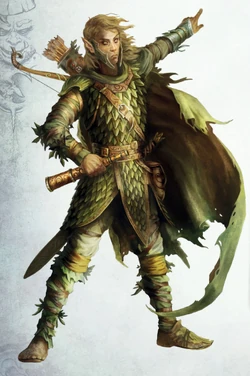
An Expatriate seeing the sights
Expatriate Elves find themselves treated as aliens within the Empire, for their long-term views are seen as "flippant" and "shallow" among more serious-minded Imperials. It is true, also, that superstitions have built up around the Elves, and these affect their relations with Humans, too.[1b] Behind their haughty and flippant façade, however, the Wood Elves of Laurelorn know they are within the Empire, and it is with the Empire that they must deal. In their hearts and minds, during quiet moments of reflection, they know that they are a dying people and that they need the Empire and its teeming masses of Men for their protection. Acknowledging this unpleasant truth, some Wood Elves have decided to end their isolation and enter the Empire, just to make sure the Humans do not foul things up.[1c] Other reasons an Eonir might leave Laurelorn include a definite mission from their leaders, simple sightseeing, or because an elf does not fit in to their own society.[1b]
Although almost all elven adventurers in the Empire hail from Laurelorn,[1b] they are not numerous enough to form their own quarters within the Empire's towns and cities, the Elves are most often encountered singly, as wandering entertainers or travellers out seeing the sights.[1c]
Elf experts are welcome in the houses of nobility and the wealthy, where they serve as tutors, sword masters, archery instructors, huntsmen, and "trophy" courtiers. Wood Elves encountered in a group are likely to be an ambassador and his retinue on their way to meet with some Imperial grandee over matters of trade or security — or to complain about the mistreatment of Wood Elves at the hands of Humans and Dwarfs![1c]
Humans' opinions of the Wood Elves comprise a mixture of admiration, envy, fear, and some irritation. Their wizards know powerful sorceries unknown to others and, as a species, they live much longer than Humans. Their warriors have a deadly skill that more than makes up for any lack of numbers, and their secretiveness makes others wonder what they are hiding behind the trees of Laurelorn. All this is made worse by what appears to Humans and Dwarfs as a smug air of superiority, that the Wood Elves are talking down to them. The Elves do not see it that way. Rather, many feel they simply have to be patient with those slower than themselves, putting subtle concepts in terms a barbarian's descendant can understand.[1c]
Dwarfs try to have as little to do with Elves as possible, still holding dear their grudge from the War of Vengeance, which those flippant Elves call "The War of the Beard." Dwarfs and Humans can do just fine managing the Empire; they do not need a bunch of snooty tree-lovers telling them how to mind their affairs. When they do mix, a Dwarf will often go out of his way to insult or embarrass an Elf just to "take him down a notch or three."[1c] Halflings have little contact with the Elves, except as the latter's travels take them through the Empire. Their attitudes toward the Wood Elves mirror those of the Humans, though they are perhaps less prone to either fawning worship or outright hostility.[1c]
Military[]
"That's the difference between us. We elves fight because we must; you humans fight because you like it."
- —Gilathel, Kithband Warrior.[3d]
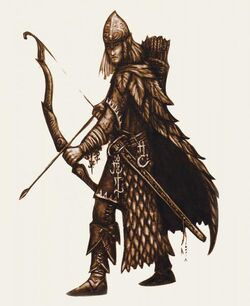
An Eonir warrior.
The Eonir have successfully defended Laurelorn from all manner of creatures- orcs, Humans, and even Dark Elves.[1c] However, as the taint of chaos grows worse, their position in the dark forests of the Empire becomes increasingly precarious. In recent years, the Elves have had to spend more and more time in military pursuits.[3b]
Eonir Infantry[]
- Kithband Warriors - The kithbands, small groups of related Elves, form up into units when they go to war. These bands carry their clan's emblem and are typically armed with bows.[3b]
- Ghost Striders - Ghost Striders are solitary elven archers who roam all over the Old World, hunting down the creatures of Chaos. They are almost supernaturally stealthy, and can pass unseen through forest and mountain. Ghost Striders are all archers skilled to the highest degree, and are famed for never missing their targets. However, Ghost Striders tend to be individualistic, often more at home alone in the natural world than around other sentient beings.[3c]
Sources[]
- 1: Warhammer Fantasy Roleplay 2nd Edition: Sigmar's Heirs (RPG)
- 2: Warhammer Fantasy Roleplay 4th Edition: Core Rulebook (RPG)
- 3: Warhammer Fantasy Roleplay 2nd Edition: Core Rulebook (RPG)
- 4: Wolf of Sigmar (Novel) by C.L. Werner
- 4a: Ch. VII
- 5: Warhammer Fantasy Roleplay 1st Edition: Something Rotten in Kislev (RPG)
- 5a: Handout 6
- 6: Warhammer Fantasy Roleplay 2nd Edition: Career Compendium (RPG)
- 6a: pg. 121
- 7: Warhammer Fantasy Roleplay 4th Edition: Archives of the Empire Vol I (RPG)

